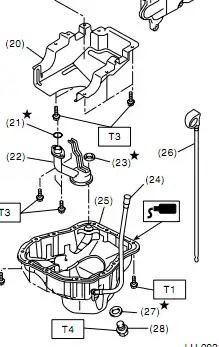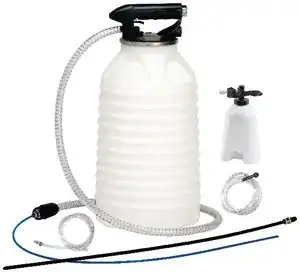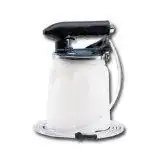I have one of these. Inserting the suction hose into the dipstick tube didn't allow me to remove even half of the oil (the container is marked to show the level of the contents, though it's hard to read except in bright sunlight).
However, there is an easy solution! Measure the dipstick tube diameter and go to your parts shop for a suction hose with a matching interior diameter (specify one that won't melt at 250*F). Put a touch of oil on the outside of the dipstick tube, as lubricant, and slide the new hose over the outside of the dipstick tube. When you start pumping, the suction will draw the oil up out of the engine. Using this technique I have been able to extract 4.25 quarts from my 4.5 qt engine, which is as much as I get by opening the drain bolt.
Some problems with the device:
- The suction hose does not thread into the vacuum chamber, causing it to lose vacuum pretty easily, and occasionally pop off completely. This is probably the biggest flaw.
- You have to pump almost constantly to extract the oil if the device is placed above the sump.
- Cleanup is a PITA.
Still, I use the thing. The first time I used it, it was the easiest oil change I ever did, and each time is just a bit easier. It is also much easier to dispose of the used oil this way (I just drive the entire device to a local Jiffy Lube and pour it into their waste barrel, wipe it down with newspaper and store it in a moving crate that I prepped).
Some tips:
- The hose pops off of the chamber pretty easily. I affix it with tape now, as once it popped off mid use, making a huge mess.
- There will be a film of oil on the outside of the dipstick tube once you remove the suction hose. Have some newspaper ready.
- If you can get the top of the chamber lower than the sump, you'll be able to set up a siphon. Slow but easy.
- The oil has to be hot, which you know, but not so hot that it melts the hose.
- Get a large bag or box to store the thing in, and line it with oil-absorbing mats (3M "HiSorb" (or something like that) mats are cheap and work great). Before you start :)
If I could go back in time, I wouldn't have spent the money on this. It's good, but even better would be something set up on your drill, like this DIY pump, so you don't need to extract it all manually.


